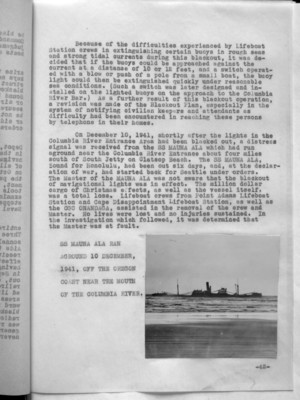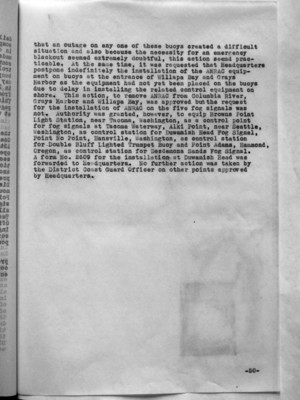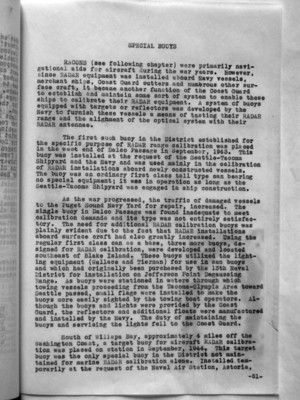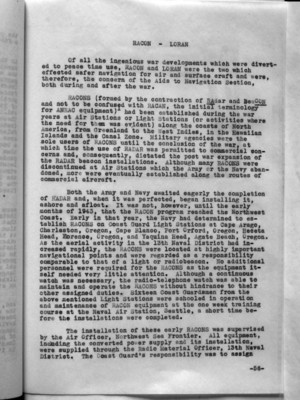Pages That Mention Seattle
Coast Guard District narrative histories 1945
11
labor consumed far too much valuable time, and so it became expedient that there be a swifter method. By 1942, Headquarters developed a radio control system for aids to navigation intended primarily for blacking out unattended lighted aids by means of radio signal. The system was designated by the coined word "RACAN" which was later changed to ANRAC to avoid confusion with RADAR beacons or RACONS.
After a thorough study of the use of ANRAC, the District Coast Guard Officer, 13th Naval District, requested Headquarters' authority to install the equipment with the Cape Disappointment Light Station as the control unit for the radio extinguishing of ten buoys in the lower Columbia River. Because of the delay in the delivery of ANRAC equipment, it was not until March, 1944 that the first two ANRAC equipped buoys were placed on station. All maintenance and repair work for this installation of special buoy equipment was handled at the Tongue Point Repair Base, Tongue Point, Oregon. Later at the request of the Commandant, 13th Naval District, the District Coast Guard Officer requested that ANRAC controlled buoys be placed in the Grays Harbor and Willapa Bay areas. Headquarters authorized these installations, but later experiments with ANRAC did not prove satisfactory and permission was requested of Headquarters to discontinue this type of equipment. This request to remove ANRAC equipment from the Columbia River, Grays Harbor, and Willapa Bay was finally approved.
Early in 1943, the Navy had decided to install RACONS on Coast Guard Light Stations at Cape Arago, Cape Blanco, Heceta Head, and Yaquina Head in Oregon. Sixteen Coast Guardsmen were schooled in the operation and maintenance of RACON equipment at a one week training course at the Naval Air Station, Seattle, a short time before the installations were completed. By the end of May, 1943, RACONS were in operation at the above Coast Guard units as well as at the Port Angeles Air Station and the Cape Flattery Light Station.
At the beginning of 1944, the Chief of Naval Operations directed the transfer of all Navy "pulse" equipment to the Coast Guard for operation and maintenance. The first RACON station to be transferred was the installation at Tillamook Naval Air Station which was assumed by the Coast Guard on 1 May, 1945. The stations at Shelton, Quillayute, Whidby Island, and Seattle in the state of Washington, and Astoria, and Oceanside in Oregon were transferred to the Coast Guard. Other RACON units were established subsequently in the 13th Naval District. At the conclusion of the war, various Auxiliary Stations were discontinued and the RACON stations at each were placed in caretaker status.
-28-
62
Because of the difficulties experienced by Lifeboat Station crews in extinguishing certain buoys in rough seas and strong tidal currents during this blackout, it was decided that if the buoys could be approached against the current at a distance of 10 or 12 feet, and a switch operated with a blow or push of a pole from a small boat, the buoy light could then be extinguished quickly under reasonable sea conditions. (Such a switch was later designed and installed on the lighted buoys on the approach to the Columbia River Bar.) As a further result of this blackout operation, a revision was made of the Blackout Plan, especially in the system of notifying civilian keepers and attendants as difficulty had been encountered in reaching these persons by telephone in their homes.
On December 10, 1941, shortly after the lights in the Columbia River Entrance Area had been blacked out, a distress signal was received from the SS MAUNA ALA which had run aground near the Columbia River Entrance about four miles south of South Jetty on Clatsop Beach. The SS MAUNA ALA, bound for Honolulu, had been out six days, and, at the declaration of war, had started back for Seattle under orders. The Master of the MAUNA ALA was not aware that the blackout of navigational lights was in effect. The million dollar cargo of Christmas effects, as well as the vessel itself, was a total loss. Lifeboat crews from Point Adams Lifeboat Station and Cape Disappointment Lifeboat Station, as well as the CGC ONANDAGA, assisted in the removal of the crew and Master. No lives were lost and no injuries sustained. In the investigation which followed, it was determined that the Master was at fault.
SS MAUNA ALA RAN AGROUND 10 DECEMBER, 1941, OFF THE OREGON COAST NEAR THE MOUTH OF THE COLUMBIA RIVER.
(image)
-42-
70
that an outage on any one of these buoys created a difficult situation and also because the necessity for an emergency blackout seemed extremely doubtful, this action seemed practicable. At the same time, it was requested that Headquarters postpone indefinitely the installation of the ANRAC equipment on buoys at the entrance of Willapa Bay and Grays Harbor as the equipment had not yet been placed on the buoys due to delay in installing the related control equipment on shore. This action, to remove ANRAC from Columbia River, Grays Harbor and Willapa Bay, was approved but the request for the installation of ANRAC on the five fog signals was not. Authority was granted, however, to equip Browns Point Light Station, newar Tacoma, Washington, as a control point for fog signals at Tacoma Waterway, Alki Point, near Seattle, Washington, as control station for Duwamish Head Fog Signal, Point No Point, Hansville, Washington, as control station for Double Bluff Lighted Trumpet Buoy and Point Adams, Hammond, Oregon, as control station for Desdemona Sands Fog Signal. A form No. 2609 for the installation at Duwamish Head was forwarded to Headquarters. No further action was taken by the District Coast Guard Officer on other points approved by Headquarters.
-50-
71
SPECIAL BUOYS
RACONS (see following chapter) were primarily navigational aids for aircraft during the war years. However, since RADAR equipment was installed aboard Navy vessels, merchant ships, Coast Guard cutters and numerous other surface craft, it became another function of the Coast Guard to establish and maintain some sort of system to enable these ships to calibrate their RADAR equipment. A system of buoys equipped with targets or reflectors was developed by the Navy to furnish these vessels a means of testing their RADAR range and the alignment of the optical system with their RADAR antennae.
The first such buoy in the District established for the specific purpose of RADAR range calibration was placed in the west end of Dalco Passage in September, 1943. This buoy was installed at the request of the Seattle-Tacoma Shipyard and the Navy and was used mainly in the calibration of RADAR installations aboard newly constructed vessels. The buoy was an ordinary first class tall type can bearing no special equipment; it was in operation as long as the Seattle-Tacoma Shipyard was engaged in ship construction.
As the war progressed, the traffic of damaged vessels to the Puget Sound Navy Yard for repair, increased. The single buoy in Dalco Passage was found inadequate to meet calibration demands and its type was not entirely satisfactory. The need for additional RADAR calibration buoys was plainly evident due to the fact that RADAR installations aboard surface craft had also greatly increased. Using the regular first class can as a base, three more buoys, designed for RADAR calibration, were developed and located southeast of Blake Island. These buoys utilized the lighting equipment (Wallace and Tiernan) for use in can buoys and which had originally been purchased by the 13th Naval District for installation on Jefferson Point Degaussing Range. As buoys were stationed in waters through which towing vessels proceeding form the Tacoma-Olympia Area toward Seattle passed, small flags were installed to make the buoys more easily sighted by the towing boat operators. Although the buoys and lights were provided by the Coast Guard, the reflectors and additional floats were manufactured and installed by the Navy. The duty for maintaining the buoys and servicing the lights fall to the Coast Guard.
South of Willapa Bay, approximately 4 miles off the Washington Coast, a target buoy for aircraft RADAR calibration was placed on station in September, 1944. This target buoy was the only special buoy in the District not maintained for marine RADAR calibration alone. Installed temporarily at the request of the Naval Air Station, Astoria,
-51-
76
Of all the ingenious war developments which were diverted to peace time use, RACON and LORAN were the two which effected safer navigation for air and surface craft and were, therefore, the concern of the Aids to Navigation Section, both during and after the war.
RACONS (formed by the contraction of RAdar and BeaCON and not to be confused with RACAN, the initial terminology for ANRAC equipment)¹ had been established during the war years at Air Stations or Light Stations (or activities where the need for them was evident) along the coasts of North America, from Greenland to the West Indies, in the Hawaiian Islands and the Canal Zone. Military agencies were the sole users of RACONS until the conclusion of the war, at which time the use of RADAR was permitted to commercial concerns and, consequently, dictated the post war expansion of the RADAR beacon installations. Although many RACONS were discontinued at Air Stations which the Army or the Navy abandoned, more were eventually established along the routes of commercial aircraft.
Both the Army and Navy awaited eagerly the completion of RADAR and, when it was perfected, began installing it, ashore and afloat. It was not, however, until the early months of 1943, that the RACON program reached the Northwest Coast. Early in that year, the Navy had determined to establish RACONS on Coast Guard Light Stations at Cape Arago, Charleston, Oregon, Cape Blanco, Port Orford, Oregon, heceta Head, Florence, Oregon, and Yaquina Head, Agate Beach, Oregon. As the aerial activity in the 13th Naval District had increased rapidly, the RACONS were located at highly important navigational points and were regarded as a responsibility comparable to that of a light or radiobeacon. No additional personnel were required for the RACONS as the equipment itself needed very little attention. Although a continuous watch was necessary, the radio-telephone watch was able to maintain and operated the RACONS without hindrance to their other assigned duties. Sixteen Coast Guardsmen from the above mentioned Light Stations were schooled in operation and maintenance of RACON equipment at the one week training course at the Naval Air Station, Seattle, a short time before the installations were completed.
The installation of these early RACONS was supervised by the Air Officer, Northwest Sea Frontier. All equipment, including the converted power supply and its installation, were supplied through the Radio Material Officer, 13th Naval District. The Coast Guard's responsibility was to assign
-56-




